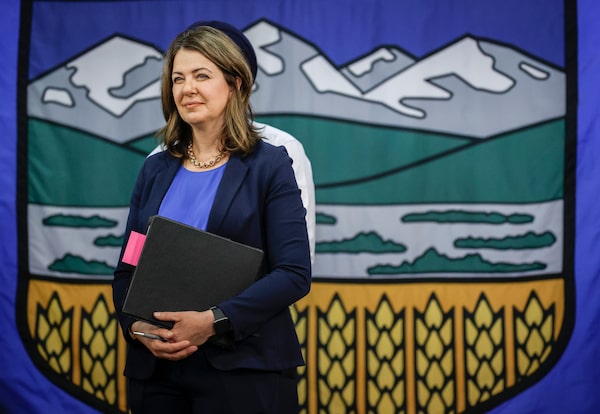
Alberta Premier Danielle Smith makes an election campaign announcement in Calgary on May 26. Ms. Smith has begun talking about the potential for a 'reset' of the Ottawa-Alberta relationship, even when discussing areas where the province still has concerns.Jeff McIntosh/The Canadian Press
The first federal-provincial meeting on energy and climate following Danielle Smith’s election as Alberta Premier has gone off in cordial fashion, with thorny policy differences still in the picture but both levels of government professing a constructive gathering. The lack of combativeness feels like a much-needed respite – however temporary – following a cantankerous provincial election campaign, and in the midst a highly politicized atmosphere in Ottawa.
Ms. Smith rose to become United Conservative Party Leader last year in part because she promised a Sovereignty Act, constitutional challenges and the end of what she described as “ineffective letter-writing campaigns and empty rhetoric employed by past premiers in dealing with attacks on Alberta by our federal government.” With this combative stance, she won the hearts and minds of the provincial conservatives angriest at central Canada.
Now she’s talking about the potential for a “reset” of the Ottawa-Alberta relationship, even when discussing areas where the province still has concerns. Never mind the federal government’s Just Transition/Sustainable Jobs legislation, there are two far more significant policies in Alberta’s crosshairs: the proposed oil and natural gas production emissions cap, and 2035 net-zero power grid regulations – the latter of which could take shape in draft regulations as early as this summer.
The province says these measures would hit Alberta’s (and Saskatchewan’s) economy in a lopsided way compared with the rest of the country, causing significant job losses and scaring away new investment dollars.
In a statement, Alberta’s Premier described Monday’s meeting between her government and federal Natural Resources Minister Jonathan Wilkinson and Intergovernmental Affairs Minister Dominic LeBlanc as hopefully a positive sign that the two levels of government can work together.
In an interview, Mr. Wilkinson said Ms. Smith was forceful in raising her province’s concerns but “was open to the conversation about how we can actually close the distance between us.
“I take her at her word that she wants to collaborate and I hope she takes me at my word that I do, too.”
He also spoke to the timeline for the federal government releasing more details on its planned cap on emissions for the oil and gas industry, casting doubt on whether the details of the complicated policy would be ready by the end of this year.
“We’re still several months, at a minimum, from being in a position to actually outline any kind of an architecture for the cap,” Mr. Wilkinson said. “We still have a lot of work to do.”
This policy is particularly contentious because Alberta argues that the goal as laid out now – requiring oil and gas producers to reduce greenhouse gas emissions by 42 per cent by 2030 – would act as a de facto production cap. Mr. Wilkinson has said that’s not the case. Some of the toughest discussions will be in the weeds, around what sets of data are used, and what Mr. Wilkinson said is “technically feasible.”
The federal Clean Electricity Standard to achieve a net-zero emissions grid by 2035 might end up being a more contentious, and immediate, issue. Draft regulations for public comment are expected in short order. But in a province that sits on massive reserves, Alberta policy-makers believe quickly moving away from using natural gas for electricity generation doesn’t make sense when Canada is building LNG export facilities that will send product to Asia for decades still. Alberta will transition off coal-fired power by the end of this year, a major milestone, but still relies heavily on natural gas for power generation.
Mr. Wilkinson said clean power will be the basis for companies deciding whether to invest in mining, manufacturing or hydrogen production in the years ahead, but the federal government knows not every province can be a hydro superpower like Quebec and British Columbia.
“We need to ensure there’s a continuing role for natural gas,” Mr. Wilkinson said. “At some point it will need to have carbon capture, for sure. But that there’s going to be some flexibility in terms of how that gets done.
“We understand that the system has to be not just emissions-free, but it has to be reliable. I t has to be affordable for consumers, and competitive for companies.”
In the larger picture is what Canada needs to do in the global push to slow climate change in a world now hit by wildfires, floods and warming seas. Tuesday saw the release of the Canadian Energy Regulator’s report on the global energy transition, looking at three different scenarios for what the landscape for electricity, fossil fuels and renewables could look like in our country in the decades ahead.
Of key disagreement amongst policy-makers is how much global demand for oil and natural gas will soften, and whether Canada can be one of the world’s last producers.
“Canada exports most of its oil production, meaning our producers depend on markets outside of Canada to buy most of our oil supply,” the CER report noted.
“Demand for Canadian oil depends very strongly on how aggressively the world pursues emission reductions.”
In all this back and forth, the Alberta Premier is proposing the creation of a bilateral working group made up of representatives of both levels of governments to discuss emissions reductions to 2050, rather than nearer term actions. There is no word yet on whether Ottawa will accept that invitation from Canada’s squeaky wheel province, and what exactly Ms. Smith will do if her demands on energy and climate policy aren’t met.